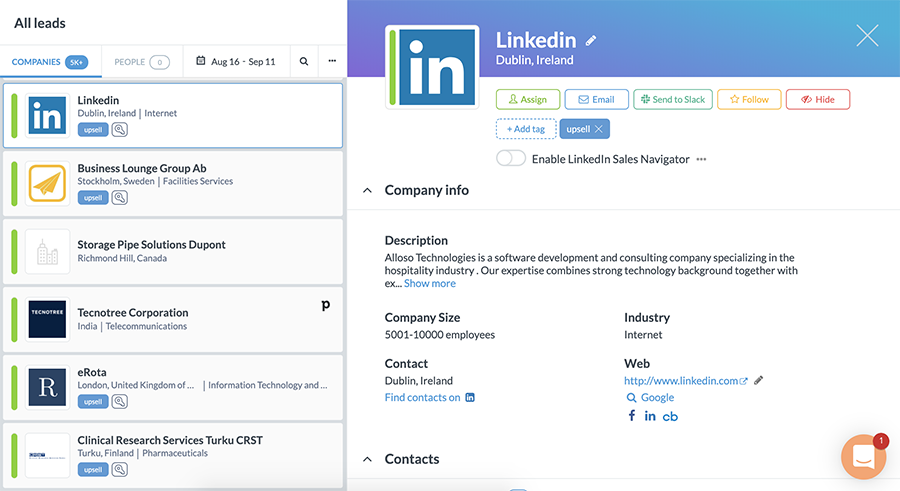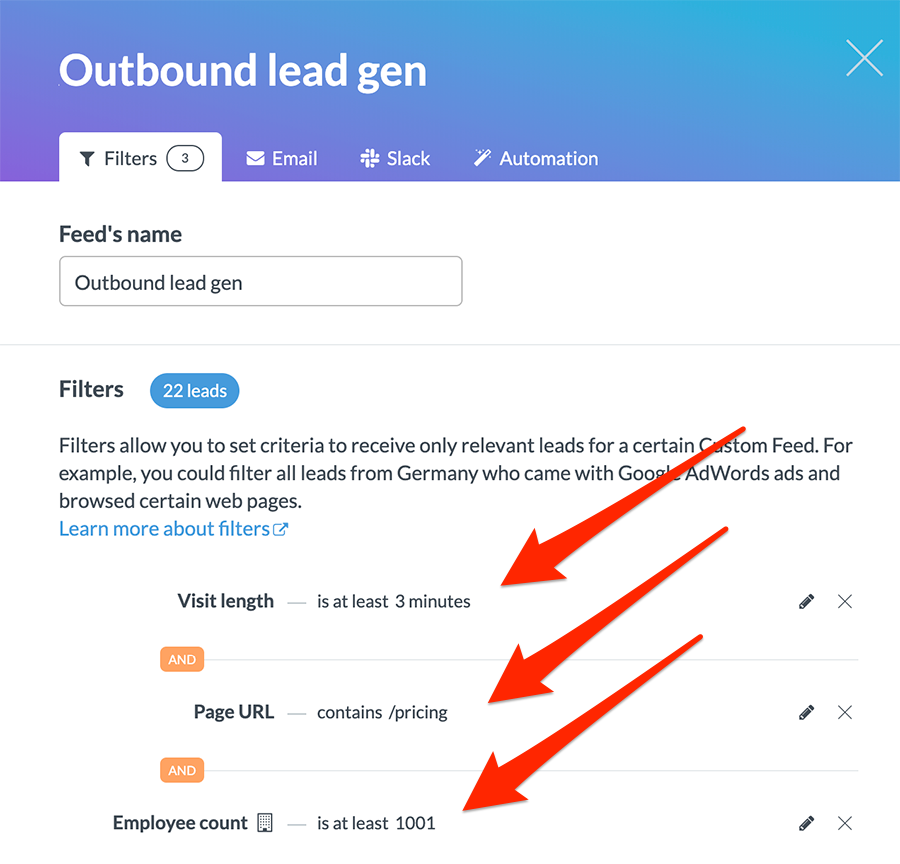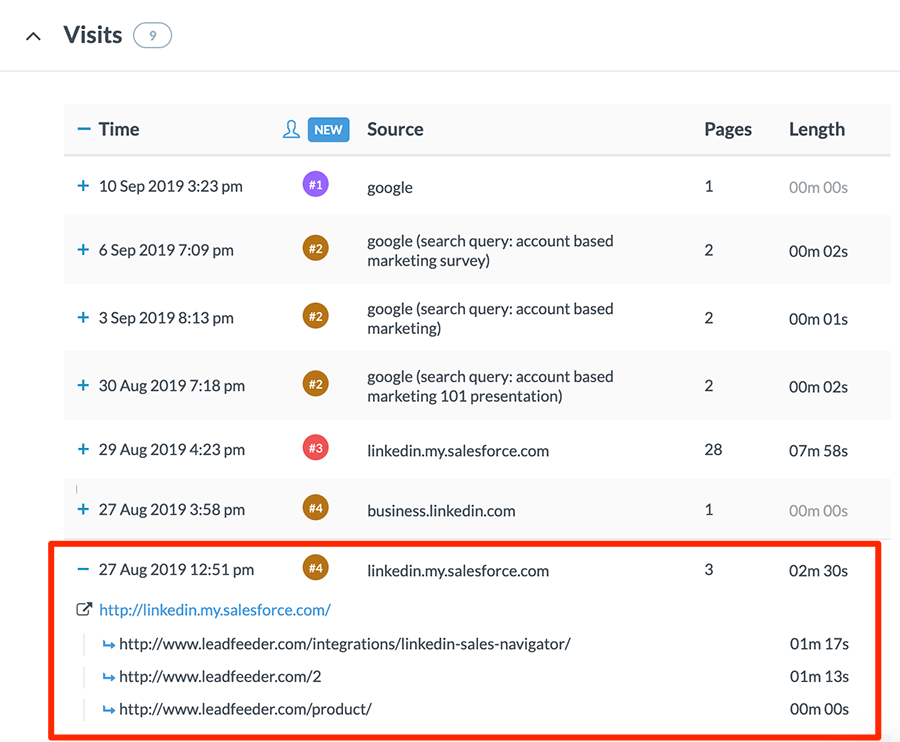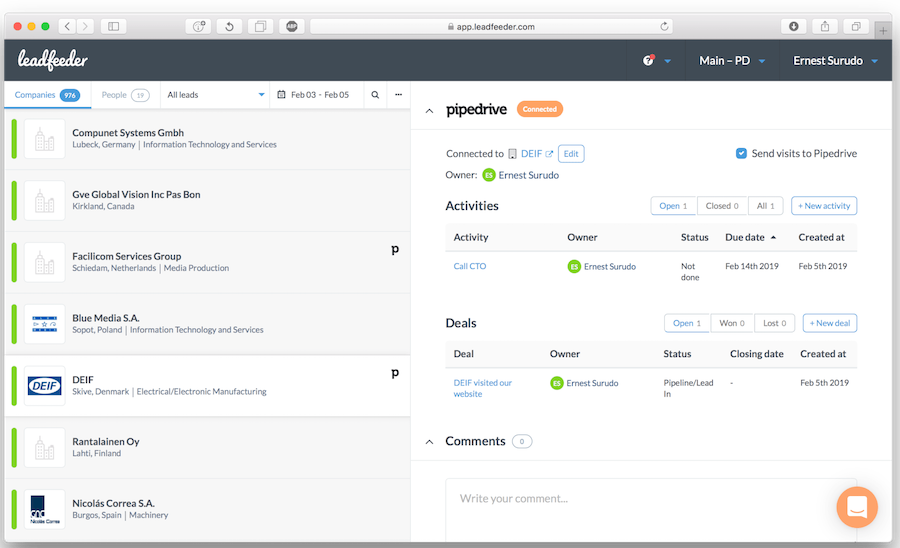Many articles focus on giving textbook definitions of inbound and outbound lead generation, then encourage marketers to choose one for their business. But that’s not the best approach—because lead generation strategy isn’t a zero-sum game. And by favoring one over the other, B2B marketing teams are likely missing out on quality leads.
Instead, inbound and outbound lead generation should work together. The problem is, with all of the recent emphasis on inbound, many of today’s marketers don’t understand or practice outbound tactics much at all. Plus, outbound lead generation comes with its own host of challenges that many B2B marketers and salespeople aren’t sure how to combat. Challenges like:
Knowing who to target
Qualifying leads
Working together with inbound lead generation efforts
All of those challenges can be solved by using visitor identification software (like Leadfeeder) to help define and refine your target audience.
In this article, we explain the difference between inbound and outbound lead generation and why they should complement one another. Then we dig into the challenges today’s B2B companies face with outbound lead generation and explain how visitor identification can make it better.
Note: Want a lead generation tool that’s built for B2B? Sign up and try Leadfeeder free for 14 days to view company names, details, and behavioral data for every company that visits your website.
Inbound vs. Outbound Lead Generation
The difference between inbound and outbound lead generation is pretty simple, but it can make a big difference in your approach. Simply put, inbound lead generation includes all of the marketing activities you do to attract potential leads and customers to you. Much of the marketing strategy and tactics that get airtime these days fall into this bucket, including:
Content marketing
Email marketing
SEO
Social media marketing campaigns
Leads that come from those campaigns are reaching out to you to enter the sales process—inbound. They’re subscribing to your email list or filling out a capture form.
Outbound marketing tactics, on the other hand, happen when marketers and salespeople go out and find new leads to reach out to. Most advertising (except for retargeted ads) falls under outbound lead generation. So does cold calling and emailing. So does some account based marketing.
The primary difference, then, is who reached out first—your company or the potential customer?
The Challenge of Outbound Lead Generation
If you’ve spent more than five minutes marketing in the last 15 years or so, you know that inbound marketing and lead generation have been crowned king, queen, and jester. But if your B2B company is only doing inbound lead generation, you’re missing out.
That’s because, regardless of how effective your inbound efforts are at driving people to your website, you only ever see about 2% of those leads convert by filling out a form or otherwise contacting you. The average B2B company sees around 2% conversion on their website—so if you’re only using inbound lead generation, you’re missing the other 98% of potential leads.
For that reason, employing outbound lead generation efforts is a no-brainer for B2B companies. So why aren’t more doing it?
The reality is, there are a few roadblocks to making outbound lead generation worthwhile for marketers and salespeople.
If you’re targeting companies who didn’t fill out a form, how do you know who they are? Who do you target?
Even if you can identify companies for outreach, how do you qualify them before spending time and money on outbound efforts?
How do you gain enough understanding of their unique needs to tailor a winning pitch?
If you’re using both inbound and outbound lead generation together (which you should be), how do you ensure your efforts aren’t redundant?
Challenges like these are what stand between B2B marketers and sales reps and effective outbound lead generation. In a nutshell, how do you identify and sell to companies you can’t see?
Visitor identification software is the missing piece that can solve for that problem.
Visitor Identification is the Missing Piece for B2B Outbound Lead Generation
All of the big challenges that come with outbound lead generation center around a lack of information—information on who these potential leads are and what they’re likely interested in (with regard to your company).
Leadfeeder is built around bringing information like that to light, for any company that visits your website—not just the 1% who fill out a form. With visitor identification data from Leadfeeder, you can:
Identify potential leads on the account level
Pre-qualify leads before you spend time on outreach
Access the context you need to craft a tailored, winning pitch
Integrate with popular CRMs to ensure your efforts align with your wider strategy and aren’t redundant
Identify Potential Leads on the Account Level
Outbound lead generation can feel like an empty slate. Where do you start? Who do you even target in the first place? With a tool like Leadfeeder, you can see the companies that visit your website and don’t convert. We think that’s a pretty good place to start your outbound efforts.

Each company page includes company info, potential decision makers, behavioral visit data, and more.
Leadfeeder identifies website visitors by the company they work for—so you’ll get account-level information designed for B2B marketers and sales teams. Plus, each company’s page includes company info, in-depth website visit activity, potential contacts, and more.
Qualify B2B Leads Before You Spend Time on Outreach
For many B2B companies, reaching out to every company that visits your website just isn’t feasible. You want to spend your precious time and effort talking to qualified leads who are actually a good fit to become customers.

Custom Feeds enable you to pre-qualify potential leads by website activity, company info, and more.
At Leadfeeder, we get that—it’s why we built Custom Feeds.
By creating a Custom Feed, you can automatically qualify website visits into best-fit leads. With filters like company size, geographic location, and behavioral filters, you can narrow down your outbound efforts to a manageable and targeted list of potential leads.
Enter the Conversation with More Context for a Tailored, Relevant Pitch
It’s no secret that the most effective lead generation efforts are driven by an understanding of what potential leads are looking for—what do they need from you?

In-depth visit data helps tailor and refine outbound lead generation efforts.
Leadfeeder gives B2B marketers and salespeople much deeper access to that information with in-depth website visit data. You can see which pages were visited, time spent on each page, and even how many employees from a given account have visited.
Integrate CRM Data to Ensure Your Efforts Aren’t Redundant
The last thing you need is to spend time crafting an outbound message, only to find out the account is already engaged with your company. That’s why Leadfeeder integrates with popular CRM software (including Pipedrive, Salesforce, HubSpot, and more) to pull CRM data right into the Leadfeeder app and push website visit data into your CRM.

You’ll be able to see if anyone from your team has entered an account into your CRM and get details on the engagement, activities, and deal stages.
Outbound Lead Generation + Visitor Identification
When companies focus exclusively on inbound B2B lead generation, they miss out on a huge percentage of potential leads. And while outbound lead generation has its challenges, a visitor identification tool like Leadfeeder can go a long way in bridging the gap—so you can find more B2B leads and turn them into customers.
Note: Wondering who to target with your outbound lead generation efforts? Sign up and try Leadfeeder free for 14 days to view names, details, and behavioral data for every company that visits your website.
More leads, no forms.
Sounds too good to be true? It’s not. Identify companies already visiting your website and turn them into qualified leads to fuel your sales pipeline.
Show me how






